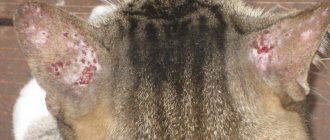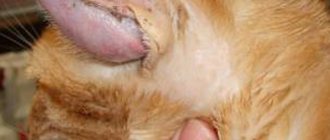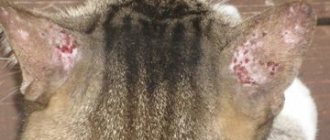Where is
The withers are the part of the animal's body located behind its head, where the neck ends and the back begins. It is this place that the common people call “shkirka”. If you want to know exactly where a cat's withers are, look at how these animals carry their babies. Pets always do this the same way. The place where a mother grabs her kittens with her teeth is the withers. Holds the cat by the scruff of the neck during mating.
Structure
So, we found out what the withers are and where they are located in a cat. How does this part of the animal’s body work? The bone base of the withers is formed by the first 5 thoracic vertebrae. They have spinous processes that give shape to this part of the body. The skin in this area of the animal is very thin and elastic. That is why kittens do not experience any pain at the moment when the mother takes them by the scruff of the neck with her teeth. The spinous processes of the vertebrae have different heights. Due to this, the animal’s withers have a slightly arched shape.
Under the skin in this place there is fatty tissue. Next come the muscles (semispinalis, rhomboid, trapezius, etc.). The joints at the withers are found only in the spine itself. A cat's shoulder blades are attached to the body solely with the help of muscles and tendons. This determines the animal’s extraordinary flexibility and its ability to make almost lightning-fast jumps.
Due to the special method of attaching the forelimbs, it is not advisable to pick up a cat by them and lift him up by weight. The animal experiences severe discomfort. It is much more correct to hold your pet behind the shoulder blades in the chest area when lifting.
A cat's withers, where the skin is not too sensitive, is still a relatively problematic place. After all, next to it is the animal’s neck. Any serious injury to this part of the body can lead to health problems for the pet or even its death. Therefore, in case of damage to the withers, owners should take their pet to the veterinarian as soon as possible.
What are the signs of various skin lesions and how to treat them?
Dermatological diseases differ in clinical signs, which should be known to all owners of four-legged pets. Therapy is prescribed by the attending physician after diagnostic measures, determining the type of pathogenic microflora, parasites, or source of stress that has penetrated. The photo below shows a sick animal.
Allergic manifestations
Allergy refers to a non-standard reaction of the immune system to foreign substances that have entered the body. The culprit may be a new type of food, exposure to household chemicals, flowering plants and their pollen, synthetics, or house dust. Clinical signs of an allergic reaction: redness of the skin, areas of inflammation, severe itching, hair loss, fever. The cat is constantly itching - from the withers to the tail, all day.
Long-term exposure to allergens leads to atopic dermatitis, asthmatic syndrome, and eosinophilic granuloma. The course of treatment includes antihistamines, antibacterial drugs (prescribed in case of urgent need and the addition of a secondary infection). To relieve itching, use specialized medicated shampoos, tinctures or herbal decoctions.
Bacterial damage
Infectious lesions occur in two variants. The dry form provokes the formation of dry, dense crusts on the cat’s skin, the wet form is determined by redness, rashes, ulcers, itching, scratching and crusts on the animal’s body. Factors contributing to the penetration of bacterial infections include:
Mycoplasmosis
- allergic reactions that provoke non-stop scratching of the dermis;
- hereditary predisposition;
- influence of stress, metabolic disorders;
- superficial wounds, neoplasms, kidney dysfunction, diabetes mellitus.
Therapy is carried out with antibiotics and local agents - Miramistin, Levomekol, zinc-containing ointments. Medicines are prescribed by a veterinarian.
Subcutaneous mites
Parasites penetrate the skin, causing discomfort in cats. There are several types of ticks.
Otodectosis
Otodectes is localized in the animal’s ears and appears due to errors in caring for the pet. Clinical signs of the disease:
- severe itching (scratching appeared);
- unpleasant odor from the ears;
- dark gray discharge;
- skin hyperemia in affected areas;
- temperature increase.
The discomfort causes an unbearable desire to scratch behind the ears; in some cats, the pathology leads to the formation of huge wounds. Further spread of the disease provokes inflammation in the outer and middle ear. The pet's balance is disturbed, the head is constantly tilted to one side. Treatment includes periodic cleansing of the ear canals from accumulated secretions and the use of acaricidal drops.
Advantage of drops
Until recently, fleas could only be removed from a cat using various types of shampoos. Today, pet stores sell all kinds of sprays against parasites, as well as drops in capsules. When using the latter, the medicine is usually applied precisely to the withers of the animal. This method guarantees that the cat will not lick the drug, get it with its paw and get poisoned. It’s clear where the cat’s withers are. Essentially, this is the highest point of the back. Therefore, after application, the medicine is distributed relatively evenly by gravity over the animal’s back and sides, which ensures the best effect. Of course, for the drug to be as effective as possible, it must be used correctly.
Causes of warts in cats
The difficulty of fighting DNA-containing viruses is that it is impossible to accurately identify the cause of its occurrence and the possible route of infection. It is believed that most representatives of any species of mammals are carriers of a “dormant” papillomavirus, which makes itself felt at a time of weakness in the body.
Note! Cat warts are not transmitted to humans.
Kittens and young animals cannot boast of stable immunity and metabolism, so they often become “victims” of warts. The same applies to older cats, their immunity is suppressed by age-related degeneration of metabolism and tissues. Adult, strong cats, ideally, do not suffer from warts, but pregnancy, childbirth, injury, stress, and drug treatment are only part of the reasons for the possible suppression of the body's immune defense.
Preparing for treatment
Thus, now the reader knows where the cat’s withers are. How to find it if you need to use medication is a simple question. However, when using the drops themselves, several important rules should be followed. Firstly, the cat should not be bathed for 2-3 days before using the medicine and for 2-3 days after that. Secondly, before using the drops, the animal’s withers must be carefully examined. If there are large lesions and wounds on it, it is better not to use the medicine. If the circumstances are unsuccessful in this case, the insecticide may enter the animal’s bloodstream, which will lead to poisoning.
When performing the procedure for applying the drug, the cat should be gently held behind its back with your left hand. You should not administer medicine to an animal that is worried about something, has become playful or is angry. The cat may jerk during the procedure to escape, and the drops will fall too low on the body. As a result, the animal will subsequently be able to reach them. Wait until your pet calms down.
How to apply flea drops onto the withers correctly for cats
The instructions for applying the drops are simple. In order to do everything correctly:
- put on medical rubber gloves;
- feel where the cat’s withers are;
- spread the fur on the animal’s neck closer to the base of the skull;
- completely squeeze the product out of the capsule onto the skin in the area of the highest spinous process;
- lightly rub the drops so that they do not flow to the side.
After using the drug, as already mentioned, it is not recommended to bathe the animal for several days. You should also not brush your cat. And, of course, you should not stroke your pet’s head or back for a couple of days. Otherwise, the medicine may get on your hands and subsequently cause poisoning in the owner. Some types of flea medications can also irritate human skin.
Causes and classification of tumors in cats
Neoplasms on a cat's neck can be of different types. The methods of dealing with the problem will depend on this.
What are the most common causes for a tumor?:
- Genetic predisposition factor;
- Injuries of any kind;
- Poor quality feeding;
- Age-related physiological changes;
- Ecology;
- Allergy.
Whatever the reason for a tumor on your cat’s neck, you should seek help from a specialist. In any case, we are not talking about a temporary phenomenon (with rare exceptions). Unfortunately, treatment does not always involve lubrication with ointments or pills. The consequences can be very serious. And everything will depend on why the cat’s neck is swollen.
It could be:
- Abscess on the neck;
- Wen in a cat;
- Benign tumor;
- Malignant tumor.
The owner will not be able to determine what exactly this lump is. To a non-professional, neither the size, nor the shape, nor the density of the formation can tell anything about why a lump appeared on the neck. This means that, with all your love for the cat, you will not be able to actively help in treating and ridding the cat of the tumor. What to do?
What is withers? Convenient place for injections
A very common medical procedure for treating animals is subcutaneous injections. Such injections are less painful than intramuscular ones and provide a high speed of action of the drugs. For cats, subcutaneous injections are given precisely in the area of the withers. After all, here the animal’s skin is thinnest and most elastic. In addition, the cat’s skin in this area is less sensitive. And therefore, your pet will not experience much pain. In addition, as a result of grabbing a cat by the scruff of the neck, its instinct of submission is activated. Therefore, the animal resists less.
What diseases can be caused
There are many diseases that cause a lump on the neck. Interstitial fluid, immune cells, and blood accumulate inside it. Each cause has a different treatment and must be diagnosed. The sooner this is done, the higher the chance of saving the cat’s life and health.
A lump under a pet's jaw should alert any owner
Benign and malignant neoplasms
A benign neoplasm is an increase in the number of different tissues that lead to a tumor. Benign means there are no stem cells that can spread throughout the body, causing metastases and organ damage. The tumor itself is not dangerous, but as it grows, the nervous and vascular tissues are compressed and neighboring organs are damaged.
How to inject into the withers correctly
It is best to inject medicine into an animal with an assistant. This procedure is carried out as follows:
- The cat is placed on its side on the table with its back to itself. The assistant must hold the animal by the hind legs and back.
- With the left hand, the skin on the withers is pulled back with a fold.
- The injection is made by pointing the needle parallel to the back.
If there is no assistant, you don’t have to place the cat on its side. In this case, it will be more convenient to place it on the floor or on the sofa. The injection is given to the animal by pressing it with the elbow of the left hand and at the same time pulling the skin with the fingers. Finding where the cat's withers are will also be easy in this case. The injection itself is done by inserting the needle no more than a third. Only a children's or insulin syringe can be used for injection.
Injuries in the withers area
Most often, such damage occurs in animals during mating. A cat rarely leaves wounds on a cat’s withers, but sometimes this does happen. To treat the area around the lesion, you first need to trim the fur. Next, you should rinse the wound with hydrogen peroxide. You can also use Terramycin spray or brilliant green.
Old wounds with signs of inflammation should be treated with antibiotics. This could be, for example, Misofenom ointment. It is applied to a napkin and applied to the wound. Then a bandage is applied. But, of course, it’s better not to let things get to the point of inflammation. If the damaged area is swollen and red, or there is pus coming out of it, you should immediately contact a specialist.
Diagnostics
To identify the cause of the seal, it is recommended to contact your veterinarian, who will prescribe the following diagnostic tests:
- general clinical analysis of urine and blood, blood biochemistry;
- puncture of fluid from the cone;
- Ultrasound of the abdomen on the left or right side, where the tumor is located;
- palpation on the right and left of the neck to determine the symmetry of the tissues and the presence of compactions;
- X-ray of the neck.
For your information! When a puncture is performed, the liquid is sent for laboratory analysis. Can detect bacteria, viruses, fungi, and various toxins. For this purpose, PCR, ELISA, bacteriological culture, and microscopy are used.
Sometimes the doctor only needs one palpation to make an accurate diagnosis.
An ultrasound scan reveals the presence of liquid or solid contents of the lump. X-rays can show tissue damage and the presence of a tumor. Using palpation, the doctor determines the density of the formation. It can be connected to the capsule or be separate from it, moving like a ball.
Interesting fact
Where the withers are located in cats, and what injuries the pet most often receives in the scruff area is therefore clear. As you can see, this place is significant for the animal’s body. Among other things, the withers also have one very interesting property. The fact that kittens calm down immediately after a cat takes them by the scruff of the neck, hang calmly and do not try to escape is well known. Why is this happening? Why do kittens hang in their mother’s teeth like lifeless “bags” in the fetal position? In fact, this behavior is primarily due to the presence of a special zone in the cat’s brain. As soon as the animal is taken by the scruff of the neck, certain impulses begin to flow from here, calming it. At the same time, the cerebellum gives the cat a signal to take a characteristic pose.
Scientists believe that such a mechanism was developed in these animals during the process of evolution. After all, a cat will not simply transfer its offspring from place to place. She acts in this way only when her children are in any danger. A screaming, attention-grabbing kitten in nature simply has a significantly reduced chance of survival.











